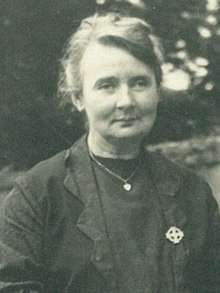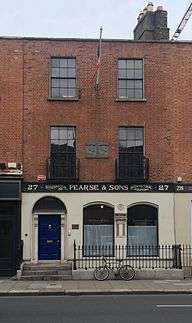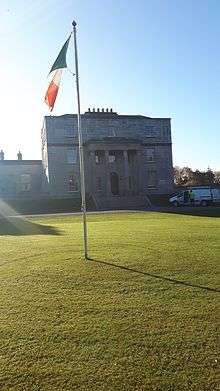Margaret Mary Pearse
Margaret Mary Pearse (4 August 1878 – 7 November 1968) was an Irish Fianna Fáil politician and teacher.[1] She was the sister of Patrick and Willie Pearse, two of the leaders of the 1916 Easter Rising.
Margaret Mary Pearse | |
|---|---|
 | |
| Senator | |
| In office March 1938 – November 1968 | |
| Constituency | Administrative Panel |
| Teachta Dála | |
| In office January 1933 – July 1937 | |
| Constituency | Dublin County |
| Personal details | |
| Born | 4 August 1878 27 Great Brunswick Street, Dublin, Ireland |
| Died | 7 November 1968 (aged 90) Linden Convalescent Home, Dublin, Ireland |
| Nationality | Irish |
| Political party | Fianna Fáil |
| Parents | James Pearse, Margaret Pearse |
| Occupation | Politician, Teacher |
Early life

Margaret Mary Pearse was born at 27 Great Brunswick Street, in Dublin, the eldest child of James Pearse and Margaret Pearse (née Brady). A family friend, Kate Brady, was present at the time of her birth.[2] She grew up in cramped living conditions as often the other rooms in the house we rented by subtenants, forcing the Pearse family to share one room.[3] During her childhood, Margaret was very friendly with James Vincent, her half-brother from her father's previous marriage. Their close relationship did not follow into adulthood.[3] She developed a close bond with her father, more so than with her mother. She was educated at the Holy Faith Convent in Glasnevin. After leaving school, she trained as a teacher.[4] Margaret did not enter paid employment after receiving her teacher training but was still interested in education. In 1905 she travelled to Belgium with her brother to study the workings of the bilingual education system and to improve her French. She tried to set up her own school for infants in 1907 in the family home on Great Brunswick Street and was constantly encouraged by her two brothers, whom assisted her in teaching on many occasions.[3] Her younger brother Willie provided art work for the classes to inspire the students.[3]
Involvement with St Enda's School
Margaret helped to found St Enda's School with her brothers Patrick and Willie in 1908.[4][5] Margaret, along with her mother Mrs. Pearse, played an intricate part in making the school a comfortable atmosphere for the students.[3] The school's prospectus lists Margaret as the Mistress of Preparatory Schools between 1909–1910[6] and as the Assistant Mistress between 1910–1911.[7] Following the executions of her brothers in the aftermath of the Easter Rising, Margaret continued to run St Enda's School. She was the matron and housekeeper for the school, while her mother was the headmaster.[8] The school began to experience financial difficulties in 1916 after the rising and was facing closure. Trips to the USA were made to raise funds for the school.[5] The school was saved mostly by donations and continued to operate even though it was operating at a loss. Margaret was directly involved with the school as she was a French teacher to junior pupils and would often write to them to keep in contact during the holidays. During the period when the school experienced staff shortages, Margaret become even more involved with the school's affairs. Her involvement helped to feed her busy and hardworking nature.[9] In 1926, Margaret went to America on a lecture tour with the intention of raising more funds for the school to cover its running costs.[4] Margaret and her mother constantly fought over how to spend the money and eventually they raised enough to buy the school grounds.[5] Margaret's mother had planned to leave St Enda's to the state in her will. However, due to legal complications, Margaret Mary inherited St.Enda's after Mrs Pearse's death in 1932. St Enda's closed in 1935 and Margaret continued to lived in the Hermitage.[9]
Margaret Mary did not always plan to leave St.Enda's to the state after her death as per her mother's wishes.[10] Eamonn de Barra along with President at the time Éamon de Valera, influenced her decision to leave the school and its grounds to the state.[11] The government also played an important part in persuading Margaret to leave the school to the nation. It guaranteed that St.Endas will always act as a memorial for her Margaret's two brothers Patrick and William Pearse and this seemed to be the final deciding factor for Margaret. An agreement was settled that while she was alive she would still be the full owner of the school and its grounds and upon her death, the schools, its contents and the surrounding land would be given to the state.[10]
Political career
She was first elected to Dáil Éireann as a Fianna Fáil Teachta Dála (TD) for the Dublin County constituency at the 1933 general election.[12] She was described as a spinster from St Endas College in Rathfarnham. She was proposed for the position by Dr. James J.McCann of 23 Terenure Road.This was seconded by Frank Burke, St. Endas, Harolds Grange, Co.Dublin.[13]
She was defeated at 1937 general election by losing on the 7th count of votes.[14] On 29 March 1938, she was elected to the Administrative Panel of the 2nd Seanad.[15] Although she had rarely spoken out in the Dáil or Seanad, or posed any questions, she was described as being a hard worker behind the scenes and rarely missed any meetings. She was often referred to as ‘Maggie’ by her colleagues.[16]
She served in the Seanad until her death in 1968 however, she and her mother were never more than figureheads for the party.[5][17] She was a founding member of the teaching staff of Ardscoil Éanna in Crumlin, Dublin, upon its establishment in 1939. Her mother Margaret Pearse also served as a TD in the 1920s and she and Margaret Mary supported de Valera because they believed he attempted to sustain Patrick Pearse's political vision.[5]
Family relations
Margaret and her sister Mary became increasingly estranged from one another due to their many disagreements. Margaret devoted the rest of her life preserving her brothers’ memory and supported her brothers’ involvement in the rising while Mary opposed it. Mary was also prone to anxiety and hypochondria. Margaret and her mother became very religious and glorified their family's part in the rising at the expense of other insurgents. They quickly condemned anyone who questioned or spoke out against the Pearse brothers. After the execution of Patrick and Willie, Margaret, Mary and her mother tried to have their bodies released but were refused.[5]
Later life
Margaret's relationship with her sister was further strained after Mary Brigid published The Home-Life of Pádraig Pearse. This edited version of their brother, Patrick's, unfinished autobiography led to a dispute over the royalties from their brother's writings as Margaret Mary believed it belonged to both of them. A court hearing was set up, however, a last minute reconciliation saw it called off. They never repaired their relationship and Mary Brigid died in 1947, twenty-one years before Margaret Mary.[18]
Illness forced Margaret into the Linden Convalescent Home in Blackrock, County Dublin when she was in her 80s. In 1965, the chairman of the Dublin Red Cross Committee awarded Margaret with a certificate for her outstanding service and contribution to the Irish Red Cross Society. She had founded the Rathfarnham Red Cross branch and she had allowed her home in St. Enda's to be used as a first aid hospital. She was still a patient in the Linden Convalescent Home at the time this award was bestowed upon her.[19]
In 1967 when she was 89 years old, her condition was described to be deteriorating.[20] However, in 1968 during the upcoming months of Margaret's 90th birthday, she left the Linden Convalescent Home for a short while in order to spend her birthday at St. Endas in Rathfarnham. The president of Ireland at the time, Éamon de Valera, went to visit her at St. Endas to congratulate her on her upcoming 90th birthday. On this visit the president was accompanied by Ann, his granddaughter. Other visitors including The Minister for Finance at the time Mr. Haughey and also The Lord Mayor of Dublin Mr. Frank Cluskey also visited Margaret in St. Endas to congratulate her on celebrating her birthday.[21]
Death

Margaret Pearse died, unmarried, at the Linden Convalescent Home, Blackrock, County. Dublin, on November the 7th 1968 and was given a state funeral.[5] Big crowds paid tribute Miss Pearse. The state funeral for Margaret was an honouring by military and civil organisations. The people who were close to her all come to the removal of her remains from Linden to Rathfarnham. The crowds gathered mainly consisted of teachers, nuns and students. There was also a big group from the Church due to their memories of the 1916 Easter Rising, to pay a tribute to the sister of the leader of the rising.[22] Margaret was buried beside her parents and sister at Glasnevin cemetery. President De Valera, the church and the state all paid tribute to her at the funeral. Over 200 soldiers gave Margaret a military honour and traffic was halted as people paid their last respects. A detour was made so that the remains should pass by Miss Pearse's old home at Saint Endas. The hearse was followed by two army jeeps filled with green, white and orange wreaths as it passed through the city. The funeral then stood still for a minute outside the general post office. The mass was held in the church of the annunciation in Rathfarnham and was held in Irish by the Rev. Thomas Walsh. After the mass, military policemen of the eastern command carried the coffin, draped in the tricolour, to the hearse and a salute was given by a special guard and officer pallbearers. The funeral then passed through Rathfarnham village where 200 boys and girls from St. Enda's High School lined the route in tribute to Margaret. As the funeral party approached Glasnevin cemetery the army band played a dead march and a special guard of over 200 men gathered to salute the hearse as it passed through the cemetery gates. The coffin was then taken to the grave where her parents and sister were and a guard of honour of the Dublin Brigade lined the path.[23] The Taoiseach's tribute to the funeral was he spoke in English and Irish. He said that Margaret Mary Pearse was the last remaining member of the noble Pearse family. He said her life like her patriotic brothers was dedicated to Ireland.[24] As per her mother's wishes, she bequeathed St Enda's to the people of Ireland as a memorial to her brother's sacrifice.[25] The school is now home to Pearse Museum.
See also
References
- "Margaret Mary Pearse". Centre for Advancement of Women in Politics (QUB). Retrieved 28 April 2009.
- "Copy of birth certificate for Margaret Mary Pearse born 4th August 1878 at 27 Great Brunswick Street, Dublin". National Library of Ireland. Retrieved 10 November 2016.
- Ní Ghairbhí, Róisín (2015). Willie Pearse. Dublin: O'Brien Press.
- Boylan, Henry (1998). A dictionary of Irish biography (3. ed.). Dublin: Gill & Macmillan. ISBN 0717125076.
- "Oxford national data base".
- "Scoil Éanna Prospectus, 1909–10" (PDF). The Pearse Museum. Retrieved 14 November 2016.
- "Scoil Éanna Prospectus, 1910–1911" (PDF). The Pearse Museum. Retrieved 14 November 2016.
- "Rules and obligations of the matron and housekeeper (Miss Margaret Pearse), the Headmaster of the school and Mrs. Margaret Pearse". National Library of Ireland. Retrieved 11 November 2016.
- Edwards, Ruth Dudley (2006). Patrick Pearse: The triumph of failure (2nd ed.). Irish Academy Press.
- "St. Enda's to be given to nation". The Irish Times. 2 February 1967. ProQuest 524860707.
- Edwards, Ruth Dudley (2006). Patrick Pearse: The triumph of failure (2nd ed.). Irish Academy Press. pp. 120, 327, 328.
- "Margaret Mary Pearse". Oireachtas Members Database. Retrieved 28 April 2009.
- "NOMINATIONS IN DUBLIN". The Irish Times. 12 January 1933. ProQuest 521917880.
- "ELECTION RESULT SHEET". The Irish Times. 8 July 1937. ProQuest 522568521.
- "THE SENATE ELECTION". The Irish Times. 29 March 1938. ProQuest 522631229.
- Clive, K. (22 April 1938). "ECHOES OF THE TOWN". The Irish Times. ProQuest 522697961.
- "Margaret Mary Pearse". ElectionsIreland.org. Retrieved 28 April 2009.
- Crowley, Brian (2013). Patrick Pearse: A life in pictures. Cork: Mercier Press.
- "Presentation to miss pearse". The Irish Times. 11 January 1965.
- "SENATOR PEARSE CRITICALLY ILL". The Irish Times. 24 March 1967. ProQuest 524573567.
- "SENATOR PEARSE'S 90th BIRTHDAY". The Irish Times. 5 August 1968. ProQuest 525048368.
- "Crowds pay a tribute to Miss Pearse". The Irish Times – via ProQuest.
- http://search.proquest.com/docview/525154848
- "State Funeral for Miss Pearse". The Irish Times – via ProQuest.
- "After the Rising | Pearse Museum". pearsemuseum.ie. Retrieved 23 July 2016.